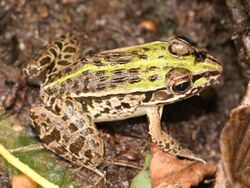Biology:Pelophylax nigromaculatus
| Pelophylax nigromaculatus | |
|---|---|

| |
| Scientific classification | |
| Domain: | Eukaryota |
| Kingdom: | Animalia |
| Phylum: | Chordata |
| Class: | Amphibia |
| Order: | Anura |
| Family: | Ranidae |
| Genus: | Pelophylax |
| Species: | P. nigromaculatus
|
| Binomial name | |
| Pelophylax nigromaculatus (Hallowell, 1861)
| |
| Synonyms[2] | |
|
Rana nigromaculata Hallowell, 1861 "1860" | |
Pelophylax nigromaculatus (formerly Rana nigromaculata), is a species of true frog found in East Asia, first described in 1861. This widespread and common frog has many common names, including dark-spotted frog, black-spotted pond frog, and black-spotted frog.[1][2]
Occurrence
It occurs across much of mainland eastern-northeastern China, the Amur River valley in Russia, the Korean Peninsula (including Ulleungdo Island),[3] and most of Japan, with the exception of Hokkaidō.[2][4] It has been considered the most-common of the true frogs on the Korean Peninsula, and has been hunted for food there for centuries, and, in modern times, used as an experimental animal.[5] There are also introduced populations in Turkmenistan,[4] Oahu, and Saipan.[6]
Habitat
The dark-spotted frog is a relatively low-altitude species, not being found above 2200 m. It ranges across a variety of habitats, from deserts and bushland to meadows and forests, and is typically found in or near stagnant or slow-moving water. Although relatively tolerant of human interference, it is increasingly threatened by hunting and water pollution.[1]
Description
Adult males measure about 62 mm (2.4 in) and females 74 mm (2.9 in) in snout–vent length.[7] The dorsal colouration varies from grey to greyish-olive, olive, and green. There are usually large dark spots, a light mid-dorsal line, and two lines on dorso-lateral folds. The belly is white. The toes are webbed. Males have a paired vocal sac and nuptial pads on the first finger.[4]
Mating season occurs soon after hibernation. Maturation probably occurs at an age of two years, and the total life span may reach 13 years.[4] The clutch size has been reported as 1800–3000[1] or 600–5000[4] eggs. The eggs are laid in shallow water.[1]
Parasites
File:Parasite140015-fig3 Protoopalina pingi (Opalinidae) Drawing.tif One species known to parasitize this frog is the opalinid Protoopalina pingi (in the rectum).[8]
References
- ↑ 1.0 1.1 1.2 1.3 1.4 Sergius Kuzmin, Irina Maslova, Boris Tuniyev, Masafumi Matsui, Li Pipeng, Yoshio Kaneko (2004). "Pelophylax nigromaculatus". IUCN Red List of Threatened Species 2004: e.T58679A11809026. doi:10.2305/IUCN.UK.2004.RLTS.T58679A11809026.en. https://www.iucnredlist.org/species/58679/11809026. Retrieved 20 November 2021.
- ↑ 2.0 2.1 2.2 Frost, Darrel R. (2017). "Pelophylax nigromaculatus (Hallowell, 1861)". Amphibian Species of the World: an Online Reference. Version 6.0. American Museum of Natural History. http://research.amnh.org/vz/herpetology/amphibia/Amphibia/Anura/Ranidae/Pelophylax/Pelophylax-nigromaculatus. Retrieved 26 April 2017.
- ↑ "Dark-spotted frog observations, Ulleung". https://www.inaturalist.org/observations?place_id=101392&subview=map&taxon_id=20978&view=species.
- ↑ 4.0 4.1 4.2 4.3 4.4 "Pelophylax nigromaculatus". AmphibiaWeb: Information on amphibian biology and conservation. http://amphibiaweb.org/cgi/amphib_query?where-genus=Pelophylax&where-species=nigromaculatus. Retrieved 10 November 2012.
- ↑ "Black-spotted Frog (Pelophylax nigromaculatus) - Species Profile". 2009-02-18. http://nas.er.usgs.gov/queries/factsheet.aspx?SpeciesID=73.
- ↑ "Pelophylax nigromaculatus (Hallowell, 1860)" (in Chinese). AmphibiaChina. Kunming Institute of Zoology. 2014. http://www.amphibiachina.org/ampsp/416. Retrieved 26 April 2017.
- ↑ 8.0 8.1 Li, Weidong; Wang, Chong; Huang, Feng; Li, Ming; Nilsen, Frank; Liu, Huiyu; Xu, Jianlong (2014). "Redescription of Protoopalina pingi Nie, 1935 inhabiting the recta of Hylarana guentheri and Pelophylax nigromaculatus in China". Parasite 21: 46. doi:10.1051/parasite/2014021. PMID 25208482.
| Wikimedia Commons has media related to Pelophylax nigromaculatus. |
Wikidata ☰ Q1072424 entry
 |


